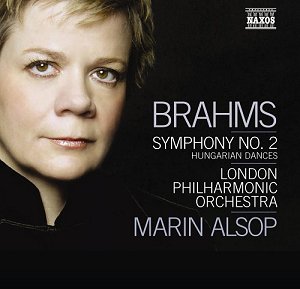Brahms spent nearly fifteen years in
the creation of his first symphony,
living in the shadow of Beethoven and
being reluctant to release a work that
would surely be compared to the elder
composer’s ninth symphony. When he finally
did finish his first, the second came
very quickly and is rather striking
in its contrast. Considerably more tuneful
and introspective, the second clearly
indicates a more relaxed, confident
composer. Brahms himself referred to
the work as "the happy symphony".
After her widely acclaimed
recording of the Symphony No. 1 reviews
, many have anxiously awaited the arrival
of the next installment in Marin Alsop’s
cycle, and I can assure you dear reader,
that you will not be disappointed. What
impressed me most was the gentleness
of her approach to this music. At over
twenty minutes, there has to be something
of interest at all times going on in
the opening movement, and Alsop finds
all of the characteristic counter-melodies
in Brahms’ score, and lovingly invites
them out to play, and sends them back
indoors when it is time for the next
guest’s appearance.
Equally remarkable
is the lush, golden tone that she gets
from the London Philharmonic’s string
section, the evenly balanced winds and
just-right juxtaposition of support
and power from the brass. Tempi throughout
are just perfect. The second movement
adagio is never syrupy; rather there
is that immediately appealing amber
quality about the sound that makes Brahms
sound like Brahms. Ms. Alsop’s glory
is in her refusal to superimpose her
own ego on the music. It still belongs
to the composer, and in her hands is
lovingly recreated, held aloft with
the utmost respect. The third movement
is played with élan and grace,
and the conclusion is never raucous,
rather, Alsop serves up a joyous, triumphant
conclusion.
The disc is filled
out with a nice sampling of the Hungarian
Dances, originally composed for piano
four-hands,
here deftly orchestrated by both Brahms
and his protégé Antonín Dvořák.
These pieces show Brahms’ oft-suppressed
sense of humor and are indicative of
the composer’s fascination with folk
music. There is nothing profound about
this music, but Alsop delivers
these little gems with panache and fun,
and they are a delightful release of
tension from the more intense symphony.
Alsop’s Brahms cycle
is one that should go alongside the
great cycles of Solti, Szell and von
Karajan as exemplary readings. That
they are available at Naxos price and
ease of acquisition is a big bonus.
This is one that you will not want to
miss, regardless of how many other recordings
you have of these works. Outstanding
on every level.
Kevin Sutton
see also review
of Symphony No 1


